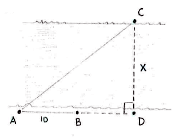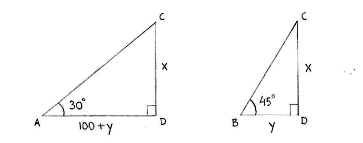Solution 4.2:7
From Förberedande kurs i matematik 1
If extend the line \displaystyle \text{AB} to a point \displaystyle \text{D} opposite \displaystyle \text{C}, we will get the right-angled triangle shown below, where the distance \displaystyle x between \displaystyle \text{C} and \displaystyle \text{D} is the desired distance.
The information in the exercise can be summarized by considering the two triangles \displaystyle \text{ACD} and \displaystyle \text{BCD}, and setting up relations for the tangents that the angles \displaystyle \text{3}0^{\circ } and \displaystyle \text{45}^{\circ } gives rise to,
\displaystyle x=\left( 100+y \right)\tan 30^{\circ }=\left( 100+y \right)\frac{1}{\sqrt{3}} \displaystyle x=y\centerdot \tan 45^{\circ }=y\centerdot 1
where \displaystyle y is the distance between B and D.
The second relation above gives that \displaystyle y=x and substituting this into the first relation gives
\displaystyle x=\left( 100+x \right)\frac{1}{\sqrt{3}}
Multiplying both sides by
\displaystyle \sqrt{3}
gives
\displaystyle \sqrt{3}x=100+x
moving all the x-terms to the left-hand side gives
\displaystyle \left( \sqrt{3}-1 \right)x=100
The answer is
\displaystyle x=\frac{100}{\sqrt{3}-1}\ \text{m}\quad \approx \quad \text{136}\text{.6}\ \text{m}


